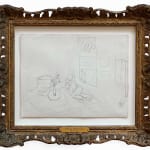Henri Matisse 1869-1954
L’atelier, Issy-les-Moulineaux, 1912
pencil on paper
21 x 27 cms
8 1/4 x 10 5/8 ins
8 1/4 x 10 5/8 ins
14915
This work is accompanied by a certificate of authenticity from Marquerite Duthuit, the artist’s daughter, dated 1981. The drawing is a study for the oil painting L’atelier aux poisons rouges,...
This work is accompanied by a certificate of authenticity from Marquerite Duthuit, the artist’s daughter, dated 1981.
The drawing is a study for the oil painting L’atelier aux poisons rouges, 1912, in the Barnes Foundation, Philadelphia; and also relates to Poissons rouges et Sculpture, 1912, in MOMA,New York.
Matisse had his studio in Issy-les-Moulineaux between 1903 and 1913, it is only at the end of the year 1913 that the painter settles in Quai Saint Michel. During this period Matisse makes manyvariations of the same theme and also realizes many works representing his studio and subsquently the works in them: through this theme, he questions the role of the painter in the world and invites the viewer to meditate on space by playing the ambiguity between interior and outside, fold and opening.
At the centre of this drawing is a depiction of Matisse’s most loved and succesful sculpture of thisperiod, Nu allongé (Aurore) I, from 1907. Cast just after this date as an edition of 10, one of these casts sold at auction in March 2018 for £14,859,000. The sculpture remained in Matisse’s studioas a treasured creation, but in this study assumes a life-like quality that could be a depcition of alive model.
We are here at the confluence of the favorite themes of Matisse, fish, odalisques, window and workshop are present. In addition, this drawing contains – as all great drawings do – a real lesson in method: infinite pursuit of signs, devices of lines whose correlations, proximities, patterns andmodels compose a logic. From this starting point Matisse was to compose two esquiste oilpaintings: L’atelier aux poisons rouges, 1912, in the Barnes Foundation, Philadelphia; and Poissonsrouges et Sculpture, 1912, in MOMA, New York.
The drawing is a study for the oil painting L’atelier aux poisons rouges, 1912, in the Barnes Foundation, Philadelphia; and also relates to Poissons rouges et Sculpture, 1912, in MOMA,New York.
Matisse had his studio in Issy-les-Moulineaux between 1903 and 1913, it is only at the end of the year 1913 that the painter settles in Quai Saint Michel. During this period Matisse makes manyvariations of the same theme and also realizes many works representing his studio and subsquently the works in them: through this theme, he questions the role of the painter in the world and invites the viewer to meditate on space by playing the ambiguity between interior and outside, fold and opening.
At the centre of this drawing is a depiction of Matisse’s most loved and succesful sculpture of thisperiod, Nu allongé (Aurore) I, from 1907. Cast just after this date as an edition of 10, one of these casts sold at auction in March 2018 for £14,859,000. The sculpture remained in Matisse’s studioas a treasured creation, but in this study assumes a life-like quality that could be a depcition of alive model.
We are here at the confluence of the favorite themes of Matisse, fish, odalisques, window and workshop are present. In addition, this drawing contains – as all great drawings do – a real lesson in method: infinite pursuit of signs, devices of lines whose correlations, proximities, patterns andmodels compose a logic. From this starting point Matisse was to compose two esquiste oilpaintings: L’atelier aux poisons rouges, 1912, in the Barnes Foundation, Philadelphia; and Poissonsrouges et Sculpture, 1912, in MOMA, New York.
Provenance
Private collection, FranceBrame & Lorenceau, Paris
Join our mailing list
* denotes required fields
We will process the personal data you have supplied to communicate with you in accordance with our Privacy Policy. You can unsubscribe or change your preferences at any time by clicking the link in our emails.



